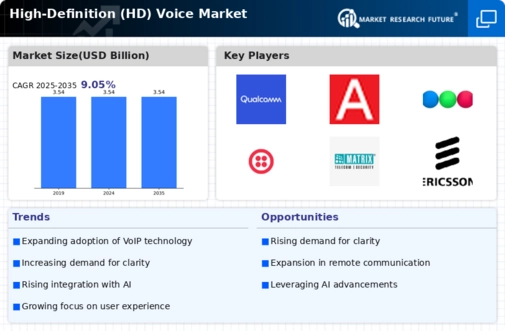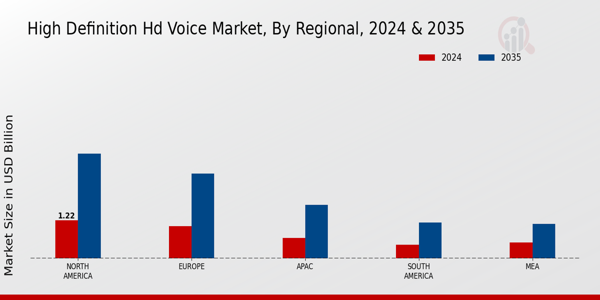The Global High-Definition (HD) Voice Market is booming due to the rising need for clear and high-quality voice communication in different sectors. Demand has increased due to remote work and virtual communication, where companies are trying to improve collaboration between teams. New improvements in audio devices have empowered users with clearer audio and fully immersive communication, making HD voice attractive for both consumers and businesses. Service providers are changing and improving the base to support HD voice features and this is an important factor for the market's growth.
There are numerous opportunities to be explored in this evolving landscape. The integration of HD voice technology with emerging communication platforms, such as unified communication and collaboration (UCC) tools, can provide enhanced user experiences. Additionally, advancements in artificial intelligence and machine learning can drive innovations in voice recognition and processing, leading to better clarity and feature enhancements. Expanding into underpenetrated markets offers potential for growth as awareness and adoption of HD voice technologies continue to rise worldwide.
There is also a notable trend toward increasing consumer awareness of sound quality, making it essential for service providers to prioritize HD voice in their offerings.Recent times have shown a shift toward mobile and cloud-based solutions, emphasizing the need for flexibility in communication. Industries such as healthcare, education, and customer service are increasingly adopting HD voice to improve interaction quality and customer satisfaction. Moreover, growing reliance on digital communication tools has led to a greater emphasis on audio quality, with users expecting seamless communication experiences.
As these trends continue to evolve, the HD voice market is likely to adapt, fostering innovation in technology and expanding its reach in various sectors.
High-Definition (HD) Voice Market Drivers
Increasing Demand for Superior Audio Quality
The growing demand for superior audio quality in both personal and professional communication environments is a significant driver of the Global High-Definition (HD) Voice Market Industry. As consumers become more accustomed to high-fidelity audio experiences, particularly from advancements in technology and inherent expectations from various applications, there is a rising shift toward HD voice capabilities.
This transition is not only observed in personal communications, such as mobile phones and VoIP services, but is also becoming predominant in business settings where clear communication can enhance productivity.The corporate sector often relies on effective communication tools to convey messages without distortion or loss of clarity. Consequently, companies are investing more in HD voice technology, recognizing its potential to improve overall communication experiences. The integration of HD voice is viewed as a competitive advantage for service providers aiming to attract and retain customers.
Furthermore, industries such as healthcare, finance, and education are increasingly prioritizing high-definition audio solutions to ensure that critical communications are conveyed accurately.As new advancements in audio compression technologies and increased bandwidth availability further elevate HD voice capabilities, this market driver is expected to play a crucial role in the growth and expansion of the Global High-Definition (HD) Voice Market.
Advancements in Telecommunications Technology
Technological advancements in telecommunications have become a pivotal driving force behind the expansion of the Global High-Definition (HD) Voice Market Industry. As telecommunication infrastructure continues to evolve, the availability of high-speed internet and improved network capabilities have considerably enhanced the performance and reliability of voice communication. Innovations such as VoLTE (Voice over LTE) and 5G technologies are facilitating clearer and more reliable voice services, which align with the increasing consumer demand for HD voice capabilities.Telecommunication companies are investing substantially in upgrading their infrastructure to support these advanced technologies, subsequently offering enhanced HD voice services to their customers.
As these advancements become mainstream, more users will likely adopt HD voice services, further propelling market growth.
Rising Adoption of VoIP Services
The rising adoption of Voice over Internet Protocol (VoIP) services is another significant market driver for the Global High-Definition (HD) Voice Market Industry. With businesses and consumers increasingly preferring internet-based communication solutions over traditional telephone services, VoIP technology is experiencing tremendous growth. This trend is driven by the advantages offered by VoIP, including cost-effectiveness, flexibility, and scalability.Enhanced HD voice quality offered by modern VoIP services caters to both personal and enterprise-level communication needs, presenting a clear incentive for users to transition to this technology.
As the usage of VoIP continues to surge, the demand for high-definition sound quality will inherently rise, further propelling the market forward.
High-Definition (HD) Voice Market
The increasing demand for superior audio quality in telecommunications is reshaping the landscape of voice communication technologies, indicating a robust shift towards High-Definition Voice solutions.
Federal Communications Commission (FCC)























